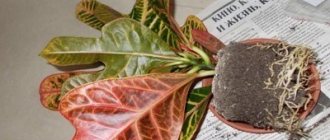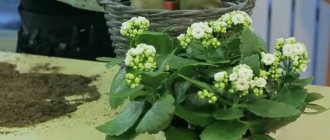Croton (or codiaum) is a houseplant distinguished by its unusual beauty.
The following types of Croton are very popular among gardeners: Motley, Petra, Excellent, Tamara.
At the same time, this is a very capricious flower that requires special care.
It should not be replanted more than once every 2-3 years.
Since replanting is difficult for , you need to know all the features of the process: when is the best time to carry it out, what kind of soil and pot is best to use, and much more.
Peculiarities
Croton is replanted once every 2-3 years ; in some cases, replanting is allowed after 4 years.
Croton should not be disturbed during the flowering period. Therefore, the optimal time for transplantation is March. It is at this time that the growing season begins.
Transplantation after purchase is very important for codiaum; it is best to do it as soon as possible.
The substrate in which the flower “lived” in the store and during transportation, at home, can lead to the leaves drying out and falling off, other Croton diseases, and even the death of the plant .
Croton is replanted for several reasons:
- becomes depleted over time and needs to be replaced;
- The root system develops and there is little room for it in the pot. Therefore, a sign that it is time to move a flower is the appearance of roots on the surface of the ground.
Each subsequent one should be 2-3 cm larger than the previous one . You should use plastic or clay ones.
Propagation by seeds
This propagation method is not popular among plant growers. After all, growing croton from seeds takes a lot of time. In addition, flowers propagated in this way do not retain varietal characteristics.
If you don’t mind experimenting, then start the event in January-February. Please note that croton seeds quickly lose their viability. Therefore, for germination, use fresh grains collected this year. Before planting, be sure to prepare the seed material. To do this, keep the seeds for half an hour in water at a temperature of +60 °C. And then soak them for a day in warm water with the addition of any growth stimulant.
Plant the prepared grains in moistened, universal soil for seedlings to a depth of 0.5-1 cm. Please note that before sowing you need to warm the mixture to +22 °C, and then you should maintain it in this condition. Therefore, you can’t do without bottom heating. After planting, stretch glass or polyethylene over the container or pot and place the improvised greenhouse in a warm place.
Regularly moisten the soil, preventing it from drying out, and use the bottom watering method. That is, place the greenhouse for a while in a basin filled with warm, settled water. And also do not forget to wipe off condensation from the shelter. Maintain the temperature near planting within +22-25 °C. Only under such conditions will croton seeds germinate at home.
Transplant instructions
The soil must first be prepared. Its composition depends on age.
For young plants, the soil for replanting consists of coarse river sand, leaf soil and turf soil, mixed in a ratio of 1:2:1. For an adult, the ratio is 1:3:1, respectively.
You can also use soil purchased at the store. It is recommended to add a little leaf soil to it Before planting, the soil should be shed with a weak solution of potassium permanganate and dried.
Drainage
must be placed at the bottom - expanded clay or clay shards. It should fill ¼ of the pot.
After preparing the pot and soil, you can begin replanting the croton:
Drainage is laid at the bottom , soil is poured on top. The earth is moistened and a depression is made in the center.
The croton is removed from the old one. You need to pull it out carefully . You cannot disassemble its roots and remove soil from them. The plant is transplanted together with a lump of earth.
The exception is a flower that is replanted after being purchased in a store. You need to shake off as much substrate as possible from the roots of such a croton. However, disassembling the roots is also not recommended;
An earthen ball with roots is placed in a recess in the new one and covered with the remains of the new soil. There should be no voids in the pot , so the earth is slightly pressed down;
The transplanted croton is watered. After transplantation high humidity , so it needs to be watered daily . also recommended to spray it with a spray bottle.
Care
When growing the codiaum variegum plant, care at home will require fulfilling a number of requirements.
Lighting
All forms and varieties of “Joseph's cloak” need bright, mostly diffused, lighting.
Windows facing west or east are considered the best for codiaums.
On the southern windows, shading is necessary - otherwise there will be burns, and on the northern windows - additional lighting so that the motley color does not disappear.
Temperature
Croton needs a warm habitat, without drafts and sudden transitions from heat to cold, with an even annual temperature variation.
Optimal ranges are 20-22 degrees in summer and 18-20 degrees in winter.
In any case, the temperature should not drop below 16 degrees. In cold soil the plant rots.
The soil
“Joseph's Cloak” feels good in loose, fertile soil with a neutral or slightly acidic reaction.
Ready-made soil mixtures are suitable for palms and ficus.
You can also mix equal amounts of turf, leaf (or peat) soil and washed river sand.
A few more recipes suitable for croton:
- Garden soil, peat and sand in a ratio of 3:1:1;
- Turf soil with small amounts of sphagnum and sand;
- Turf, leaf soil and sand in a ratio of 2:1:1.
Before filling the planting container with soil substrate, a drainage layer of expanded clay, broken bricks and pieces of charcoal must be poured onto its bottom in order to prevent stagnation of water and rotting of the root system.
Transfer
When replanting a grown plant, choose a slightly larger pot, 2-3 cm larger in diameter than the previous one.
Croton will not like an overly spacious “apartment”.
When replanting variegated croton, they try to transfer it without destroying the earthen ball.
The frequency of transplants depends on the age of the croton and the intensity of its growth.
As a rule, young specimens require an annual change of “home”.
With age, the interval between transplants will be 2-3 years or more.
It is recommended to replant codiaum purchased in a store into a “home” container with a drainage layer and fresh soil mixture, freeing its roots from the transport substrate.
Humidity
Croton is a true child of the tropics and needs year-round high air humidity: ideally it should be 70-80%.
Such a plant must be sprayed with soft water - regularly, daily, especially since it has practically no rest period.
A monthly shower is also useful, as is placing the container on a tray with wet pebbles.
Watering
For regular, abundant watering of the “Joseph’s cloak,” you need soft, well-settled, not cold water.
When dosing, it is important to follow the principle: “water, but do not overfill.” Ideally, the soil does not dry out more than 2 cm, and water does not stagnate in the pan
Ideally, the soil does not dry out more than 2 cm, and water does not stagnate in the pan.
Those gardeners who understand the language of plants well focus on the barely noticeable drooping of the codiaum leaves: as soon as this occurs, watering is needed, and quite generously.
Top dressing
From April to August, croton should receive weekly fertilizing with fertilizers for variegated or decorative deciduous plants. Alternating organic and mineral fertilizing also gives good results.
In the autumn-winter period, the frequency of fertilizing (after watering, on wet soil) is reduced to once a month.
Bloom
In the summer, under favorable conditions, crotons can bloom with inconspicuous shaggy bunches of balls.
Flowering, pollination, and ripening of codiaum seeds are a subject of interest to breeders who develop new varieties.
In the usual practice of home floriculture, the resulting buds are removed so that the codiaum does not waste energy on the development of flowers.
The very intention of the croton to bloom indicates that the plant is happy, it wants to live and reproduce here.
Reproduction
In indoor culture, codiaum is propagated vegetatively: by cuttings and layering.
Propagation by cuttings: The best are apical cuttings 10-15 cm long, with at least two pairs of leaves, cut with a sharp knife in January-April.
The cut areas are sprinkled with crushed charcoal. The milky juice is washed off, the lower cut of the cutting is treated with a root formation stimulator and placed in soil with a temperature of 25-26 degrees.
Cover with plastic wrap, ventilate regularly, moisten the substrate, and spray the cuttings.
The standard rooting period is a month.
Reproduction by air layering: With this method of propagation, a fairly long branch is selected, bent to the surface of the soil, sprinkled with it and fixed.
After the buried branch takes root and produces new shoots, it is separated from the original plant.
Seedlings (dividing the bush)
Sometimes the plant becomes too crowded in the pot. In this case, it is necessary to propagate the croton (plant).
The process is also recommended to coincide with the beginning of spring.
Pots with drainage and substrate (soil for young and adults) are pre-prepared. The day before transplanting, the plant is watered abundantly.
Seating is carried out as follows. The codiemu bush is removed and divided into several parts : the main plant and root children . A large bush is planted in a large pot with soil for an adult plant.
Small shoots are placed in small pots with soil for young flowers, covered with plastic wrap and placed in a warm place.
Propagation by part of the root
Croton has the ability to form basal shoots. As a rule, this ability appears in mature and well-developed plants.
To get a new copy by dividing the root system, you should follow a certain procedure:
- The day before the procedure, the plant should be watered well. This will make it easier to separate the root system.
- After removing the plant from the pot, separate the basal shoots from the main root.
- The adult plant is transplanted into a new pot, and the young seedlings are placed in separate containers with a shelter installed on them.
This method is very effective. Its only drawback is that it is applicable only if there is a well-developed plant with basal shoots.
Briefly about croton
Another name for Codiaum is a perennial plant that belongs to the Euphorbiaceae family. Quite beautiful, but requires attention and knowledge of care features.
The name of the flower itself comes from the ancient Greek city and means “head”. There are several versions of the origin of this name, but many are inclined to believe that its authorship belongs to the botanist Georg Rumphis.
One of the most important questions that every gardener should ask himself when purchasing is: how to replant croton?
There are several methods, but one of the best is the transfer method - transferring the plant along with a lump of soil into a new container. First, a new drainage layer of charcoal and expanded clay must be placed in the pot.
Young plants need to be replanted every year, but flowers of older generations should be replanted no more often than once every few years. It is also important to take into account that when replanting, a complete replacement of the soil is not recommended, since the root of the codiaum is very thin and difficult to adapt to changing conditions.
The flower does not need too large containers; it is important that the root fits and does not bend at the bottom. When choosing a flowerpot, you should focus on both ceramics and plastic. However, there must be holes at the bottom of the container to allow excess water to escape. Otherwise, the root may begin to rot.
This is a delicate plant that requires special attention. However, if you take into account all the nuances and look after it properly, the flower will certainly please the owner.
Description of appearance
Croton is an ornamental deciduous plant of the Euphorbia family (Molocaceae), genus Croton. Historically, croton is native to the forests of Southeast Asia, the Malay Islands, some Pacific Islands, and India.
In nature, crotons are found up to 3 m in size, but at home they require a lot of effort to reach a maximum height of 1.5 m. However, the price is worth it, because this small tree will decorate your home and become a good friend all year round.
The shape of the leaves varies from species to species, as do their varied colors.
The most common type of croton (croton spotted) has a bay leaf shape, but hybrids of this species can also be found with curly, twisted, lobed, forked and ribbon-shaped leaves.
Is it necessary to replant Croton after purchase?
Most of the flowers that arrive on store shelves either arrived from abroad in a specialized substrate for transportation, or were grown in industrial conditions.
In both cases, the substrate on which the flower grows at the time of purchase is not suitable for long-term cultivation, because:
- It is not suitable for irrigation and under the influence of water it only gets wet, not allowing the necessary oxygen to pass through;
- Stopping air access leads to the formation of rot on the roots;
- On it, during transportation, the plant suffered too much stress, which can negatively affect the condition of the codiaum.
Watering and proper lighting
From the beginning of spring to the end of summer, croton is watered very generously at home. If you overdry the soil, you can drive the plant into a long-term illness, so try not to dry out the soil by more than one centimeter. However, if you overdo it with watering, the flower may also suffer - the roots will begin to rot, as well as the flower stem itself. But from the beginning of autumn to the end of winter, it is better to reduce the amount of moisture consumed by the flower. If he lacks moisture, he will immediately report this by lowering his foliage.
The condition of the plant depends on proper watering
And even in such a situation, you should not flood the plant, just take a spray bottle with water and spray it. Of course, before watering, you need to make sure that the water is settled and maintains the temperature of the room. This flower also likes to have a lot of light, otherwise they may fade and become a uniform green color. However, you should try not to place the flower in direct sunlight, especially in the summer months, but in winter, calmly place it on a south-facing window.
“If you overwater, the flower may also suffer.”
How often should croton be replanted during cultivation?
Depending on the age of the flower, the need for replanting varies:
- It is recommended to replant mature ones no more than once every three years, as the root system grows. In this case, it is worth considering that the diameter of the new pot should be three to five centimeters larger than the old one. Don't buy too large a container;
- Young ones need annual transplantation in the spring, or in extreme cases, summer, period.
Before transplanting into a new container, it is recommended to add new fertile soil.
If you are not sure that you know exactly how and when to replant codiaum, you should not experiment. There is a high risk of damaging the plant.
In addition, during the growing process you can change the shape of the flower. By pinching off the top shoot, giving it the shape of a bush. However, it is worth considering that in this case, the formation of the crown will occur more slowly, since the lateral branches grow more slowly than the axial stem.
Before you start transplanting, it is recommended to familiarize yourself with its features. Colodium is a capricious flower that needs close care and neglect can lead to its death.
Types and varieties of croton
In indoor culture, variegated croton is grown, the distinctive feature of which is the ability to change the color and shape of the leaves depending on living conditions. It was this quality that made the species the basis for experiments in selection, which culminated in the development of many varieties, hybrid forms and varieties.
In the photo: Croton variegated (variegatum)
Croton variegated (variegatum)
grows in nature in Pakistan and China, sometimes reaching three meters in height. The leaves are short-petioled. The color of the leaves is green and brown. This species has several forms, differing in the shape of the leaves: adventitious, lobed, flat-leaved and decorated, which served as the basis for the development of many remarkable varieties:
- Mrs. Eyeston - grows as a large tree or bush with leaves brightly colored dark burgundy with bright pink spots, although there is a variety with golden leaves with almost black fragments and a variety in yellow-pink tones;
- Petra - in nature it grows to a height of up to four meters, branches well, the shape of the leaves is oval, lobed or pointed, the color is dark green with a bright yellow edging and contrasting veins and specks of the same color;
- Black Prince - its wide oval flat leaves of black-green color with many yellow, red and orange spots look very exotic;
- Disraeli has lobed leaves, colored green at the top with yellow veins and specks, and brick-brown at the bottom;
- Excellent is distinguished primarily by the shape of the leaves, reminiscent of oak leaves; the color of the lower part of the leaf is red-burgundy, and the upper part is yellow-green.
The following varieties of variegated croton are also of interest: mollucian, minus, genuine, oval-leaved, tortoiseshell, curly and spiral. But no matter what type you purchase, you can believe that it will become the most noticeable decoration in your interior.
Croton (Codiaeum) - care, photos, types Laurel (Laurus) - care, photos, types
After this article they usually read
Add a comment
What soil is needed, what fertilizers should be used
Crotons, including young ones, need fertile soil. In addition, it is important to enrich the soil with fertilizers during intensive flower growth. Almost any complex fertilizer intended for indoor deciduous plants is suitable for feeding.
It is recommended to fertilize the substrate after watering.
Since codiaum comes from the tropical zone, the substrate must correspond to the characteristics of this area.
Fortunately, preparing it is not so difficult; to do this, you need to add the following to the ground in equal proportions:
In addition, it is recommended to freeze the finished substrate before transplanting. This will prevent the development of harmful bacteria that cause diseases and destroy pest larvae.
When laying the soil, you need to place some fine charcoal in it. This is one of the best methods of protecting roots from rot.
With the correct composition of the substrate, codiaum will easily replant and will not cause any inconvenience to the owner.
Landing
In order to properly plant croton, you first need to cut a cutting on which several internodes will be located. After this, it is very important to rinse the cut with a small amount of water. In this way, it is possible to destroy the film, which can prevent the rooting process of the cuttings.
- The cut cuttings will have to be planted in the soil, which should consist of sand and earth. In this case, it is important to compact the soil a little near the planted cuttings.
- It is very important to water the planted croton. To do this, water the young plant once every 5 days. In this case, settled water is used.
- A prerequisite for rooting cuttings is the construction of a mini-greenhouse. It is very easy to make from a plastic bag. After this, the plant is placed in the shade and fresh air is allowed inside every couple of days.
Location and lighting
Croton, unlike many other plants, loves bright sunlight very much. At the same time, its foliage does not lose its original color, but only becomes stronger.
It is recommended to place the flower pot on the windowsill, which is located on the south side. In hot weather, the flower will need to create a small shade. This will help avoid severe leaf burns.
The plant can also be placed on the east and west sides of the house in a special floor stand. The flower must be placed in such a way that natural light can illuminate the croton for as long as possible throughout the day.
With the onset of cold weather, fluorescent lamps and phyto-lamps can be used for lighting.
Pot sizes
The active growth of the plant will primarily depend on the condition of the root system of the flower. It is for this reason that the choice of a flower pot must be approached with great responsibility.
The best pot for croton can be a wide, but not too deep pot. This pot size will allow the roots of the plant to be positioned with maximum comfort for the flower. If you go too far with the size, then all the water that will be used for irrigation will go to the roots. Which in turn can cause root rot.
The pot should be as stable and practical as possible. Don't pay attention to clay pots. Their disadvantage is their heavy weight and the creation of some inconveniences for the growth of the flower. The best option in this situation would be a pot made of plastic.
The soil
When planting and replanting croton, the quality of the soil is very important. In order for the plant to grow comfortably at home, it is necessary to select loose and well-drained soil. At the same time, it must be breathable and have an average level of acidity. For croton it has an approximate pH of 6.1 to 6.5.
Croton propagation by leaf
The most common method of propagation is buried shoots. To do this, use one of the branches of the mother colodiaum, which is sprinkled with soil. After some time, it should take root and the seedling is ready for transplanting.
For a plant such as codiaum, propagation by leaves or apical cuttings is not particularly common, but some gardeners also practice it.
To do this you need:
- Choose strong cuttings up to fifteen centimeters long;
- Place in a container with a mixture of water and charcoal;
- Wait until the secretion of milky juice in the cut areas completely stops;
- Remove the cuttings from the water and let them dry;
- Plant in prepared soil. Maintain greenhouse conditions until rooting.
The best time to propagate croton leaves is spring. After the cuttings take root, it is recommended to place them in a well-ventilated area and spray them every day.
After a month, the seedlings can be planted in separate containers.
Leaf propagation is one of the methods used. It is recommended to carry out such seating in the spring.
Propagation of croton by cuttings: first things first
In order to propagate croton by cuttings, it is not enough to prepare tools and auxiliary materials, such as garden shears/secateurs, a glass jar/plastic film to create a mini-greenhouse, and a nutrient substrate. You need to know exactly from which parts you can take cuttings and at what time.
His Majesty the stalk, or the one on which much depends
Here is some good news: cuttings can be taken at any time when you decide to start growing a flower. The only exception is January-February, during these months the plant sleeps, so the croton roots will produce weak ones, or even nothing at all.
But as for cuttings, the following is most suitable for them:
- apical shoot with an active bud;
- a stem shoot on which there is a single leaf;
- the woody part of the shoot even without a bud.
In a word, any part of it is suitable for propagating croton. The main thing is to cut the cuttings correctly. Each of them must be:
- at least 6-12 cm in length;
- at least 7-8 mm thick;
- have at least 1 leaf; a pair must be left for the apical shoot (for faster survival).
You need to examine the plant and identify those shoots that can be used for cuttings. A striking advantage of this method of propagation is a large amount of planting material, which means even more croton bushes on your windowsill!
Having decided on cuttings and subsequent propagation of croton, after examining the existing mother bush, you must:
Flower bed design. TOP 10 simple and effective techniques
identify shoots from which you can cut off the tops for cuttings, as well as stems from which you can make several cuttings at once; carefully cut the cuttings, laying them out on paper and not confusing where the top is and where the bottom is (for those that do not have a top); Place in warm water for a couple of minutes until the milky juice comes out
It is important to remember that the cut on the flower shoot can be sprinkled with wood ash and the emission of juice will stop; leave the cuttings in the air, leaving 1-2 leaves on each, removing the rest. What do cuttings need leaves for? They will allow the cutting line to be fully fed, taking root faster;
- after the cuttings have dried in the sun (this should not be direct sunlight!), the lower part should be dipped in Kornevin, Zircon. The preparations will not only stimulate root growth, but will also saturate the cutting with nutrients and elements necessary in the first day of establishment;
- Root the cuttings in a prepared substrate (one bought in a store will do) or in water. In the first case, to ensure the necessary humidity, the container with the cuttings can be covered with a PET bottle, jar, or a greenhouse can be built from plastic film. Be sure to ventilate! In the second, you need to monitor the temperature of the water in the container with the cuttings. A positive result - strong, numerous and healthy roots - can be achieved by providing water at 24-30°C. And no secrets!
If everything is done correctly, the roots of the cuttings will appear on days 21-30. Let them get stronger for a month and then plant the cuttings in a permanent place of growth.
- https://sornyakov.net/trees/kroton.html
- https://doma-v-sadu.ru/komnatnye-rasteniya/razmnozhenie-krotona.html
- https://fb.ru/article/451906/kodieum-razmnojenie-v-domashnih-usloviyah
- https://floplants.com/molochajnye/kodieum-ili-kroton-ukhod-razmnozhenie/
- https://letnyayadacha.ru/tsvety/komnatnye/pestrolistnye/kroton/udivitelnyj-kroton-razmnozhenie-samym-effektivnym-sposobom.html
- https://fb.ru/article/422760/kak-razmnojit-kroton-cherenki-vozdushnyie-otvodyi-i-semennoe-razmnojenie-pravila-i-osobennosti-uhoda-za-tsvetkom
- https://floradoma.net/deciduous-plants/other-deciduous/kodieum-uxod-v-domashnix-usloviyax.html
- https://sad24.ru/cvety/komnatnye/razmnozhenie-krotona.html
Features of care, pruning croton
For the croton plant, pruning or pinching is a method of forming a flower crown. The top branches are often pruned to form side shoots.
After pruning, it is recommended to treat the cut areas with charcoal powder for disinfection.
It is better to trim only flowers that have reached twenty centimeters in height. Cut branches can be used for further propagation.
In addition, it is necessary to trim dry branches or shoots damaged by pests. Pruning codiaum is an important measure aimed at forming the crown or getting rid of the affected parts.
Croton is a houseplant of amazing beauty. Capricious, it requires a lot of attention during transportation and care, but if the rules are followed, it will delight the owner with a fresh look for a long time.
More common information about caring for croton - when watching the video:
Leaf propagation: or a method that requires increased attention
Propagation of croton by leaves is also possible. However, when choosing this method, it is worth remembering that only healthy, middle-aged leaves are suitable for this. The whole process is the same as with cuttings. The only difference is that the sheet does not need to be dried for a long time.
Croton can be propagated by leaf
An important nuance that will help obtain more planting material is the ability to cut the sheet into pieces. Separate a fairly large adult leaf from the base, then carefully cut it across into 2-3 parts (width - at least 5 cm), carry out all the same manipulations as with cuttings and root it in the substrate. Rooting in water will not give a positive result, so it is better to prepare a flat bowl in advance. To root a leaf or part of it, it is enough to deepen it 2-3 cm.
Attention! When propagated by leaves, roots may appear in 30-45 days. Therefore, you should be patient! And now you are sure that several indoor oak trees will live in your house
Live and delight others, bring positivity and contribute to the implementation of the most daring plans. Look, in a couple of decades there will be a real croton grove in the house!
And now you are sure that several indoor oak trees will live in your house. Live and delight others, bring positivity and contribute to the implementation of the most daring plans. Look, in a couple of decades there will be a real croton grove in the house!
Lighting
The plant needs bright, diffused light. Croton can withstand even direct sunlight.
Moreover, the brightness of the color of the leaves depends on the intensity of the light.
A sufficient level of lighting is especially important in winter , since it is this factor that leads to the falling of leaves.
To prevent the plant from losing its decorative appearance, it is necessary to move it to the most illuminated southern window sill. In winter, you should also increase the daylight hours for this flower. Illuminating croton with special electric lamps gives good results.
How to care for codiaum
This overseas guest is quite demanding in terms of growing conditions and care. It loves high humidity and temperature, as in the tropics, so the ideal growing option is greenhouses or indoor greenhouses. But drafts are simply contraindicated; you cannot take the container with the flower outside, or leave open windows nearby, especially during the cold period.
Care consists of several components:
- Choosing a location.
- Watering.
- Temperature regime.
- Lighting.
- Feeding.
- Pest control.
- Properly organized wintering.
The plant needs a well-lit place with simultaneous protection from direct sunlight; east and west windows in the house are the best place for pots.
From lack of lighting, the leaves lose color and become faded and colorless. In winter, daylight can be supplemented with artificial lighting in the form of simple 100-watt light bulbs suspended at a distance of 70-75 cm from the crown.
Temperature for growth plays a very important role. The temperature should be constant, in winter not lower than 16 degrees, and in the rest - up to 25 degrees.
You need to water the flower moderately, constantly keeping the soil in the pot moist, but do not overfill it with water. To prevent the soil from turning sour and not being too heavy, use a pot with drainage holes and a tray with gravel.
Water for irrigation is used at room temperature; the plant may have an unpredictable reaction to watering with cold water. It is useful to frequently spray the crown with a spray bottle; in this way you can temporarily humidify the air around the pot.
Dry air contributes to the drying and falling of leaves, as well as the proliferation of weevils and spider mites.
Such dry croton branches need pruning, but be careful, pruning releases a poisonous white milk. In addition to spraying, it is worth wiping the bright leaves as they become dirty for full photosynthesis and gas exchange.
During the growing season, it is necessary to apply mineral fertilizers according to the following scheme: 2-3 times in spring, summer and autumn, and in winter once is enough. Fertilizers should be purchased in specialized stores and carefully read the instructions.
Temperature
Codiaum is thermophilic and does not like sudden changes in temperature. The flower reacts to such changes by dropping leaves.
The optimal temperature for keeping codiaum is considered to be 22-25 °C. The flower does not survive well when the temperature drops below 18 °C.
The flower requires stable temperatures throughout the year. In winter, it cannot be reduced, as this can lead to loss of leaf mass, which is very difficult to restore.
Even if it is cold in the apartment in winter, you should not place a pot with a plant near heating radiators. The radiator will create uneven heating, which can cause leaves to yellow and fall off. Place the flower in the part of the room where the temperature is most stable. You should also be wary of cold drafts.
Growing FAQs
If mistakes were made when using Croton, various problems may arise, such as:
- The bush has dropped its leaves. If the leaves of croton plants have fallen off, it means they are unable to absorb moisture. The reason for this is that the root system is in the cold. Such a bush should be moved to a well-lit and warm place, watered only after the top layer of soil has dried to a depth of several centimeters, and stop feeding for a while. After thoroughly moistening the leaves with a sprayer, a transparent cap or bag should be placed over the bush.
- The bushes are drying up. If only the lower leaves wilt, this is a natural process that will expose the lower part of the trunk. If the air humidity is not high enough, the tips of the leaves will dry out - remember that the optimal humidity level is around 70%. If brown spots appear on the leaves and the edges of the leaves dry out, this means that the room is cold and the bush is freezing. Leaves dry out and fall off if watering is too infrequent or poor.
- Leaf disease. As mentioned above, leaf loss can be caused by insufficient watering or too low humidity. The shrub may also shed its leaves if it is very cold, if it is exposed to a draft, or if there is a sudden change in temperature. What to do if the bush begins to shed its leaves? Remember the rules for caring for such a plant and understand where you went wrong, and then try to correct it.
- Why doesn't croton grow?
Poor croton growth is usually caused by poor lighting. Light is critical to the growth of croton, so it grows much less in winter than in summer.
- Why do croton leaves dry out?
Croton leaves will not dry out if the plant is watered regularly, the soil is not left dry and the air humidity is controlled. It is worth remembering that poor humidity can lead to parasites and other problems.
- Why does croton shed its leaves and what to do?
There's no need to worry if your croton sheds its leaves periodically—this is a natural process for many plants—but if your croton sheds many leaves at once, it could be caused by poor watering, insufficient humidity, sudden temperature changes, unfertilized soil, or the presence of spider mites.
- Is Croton poisonous?
Croton juice is poisonous. Its consumption causes vomiting and loose stools, and contact with skin can cause dermatitis. Care should be taken when handling the plant; it is recommended to wash your hands after each handling.
- The leaves have lost their flexibility
The problem is excessive soil moisture - frequent and abundant watering, not allowing the soil to dry out slightly. Sometimes the stems rot, and there is a danger that the roots will rot. This can be corrected by changing your watering schedule and keeping the soil dry for a few days.
Although croton looks hardy and resilient, it is one of the most demanding plants to care for. Croton requires no less attention than pets, and an unscrupulous and irresponsible attitude towards a croton can lead to its death. However, if you are ready to take on this responsible role and not lose heart in the face of difficulties, you will be rewarded with a plant of extraordinary beauty that will create a homely atmosphere and will give you joy throughout the year.
The soil
For planting, you can buy a ready-made soil mixture for decorative foliage plants or make it yourself from equal parts:
Fertilizing of codiaum is carried out during the period of active growth 2 times a week. To do this, you can use fertilizers for decorative foliage plants.
The soil for codiaum should be fertile, but easily permeable to water. To do this, use coarse sand as a leavening agent. You can replace it with other components: perlite or vermiculite.
The plant grows best in slightly acidic soils. Peat is needed to acidify the substrate. When using store-bought soil mixtures, you need to make sure that peat is included in their composition.
Common mistakes when breeding
Although the processes described above are not at all complicated, inexperienced flower growers often make mistakes that cause their flowers to grow poorly.
Did you know? When croton came to Europe, local residents believed that the flower could only be grown at high temperatures, so it was impossible to grow it at home. Accordingly, it was planted only in the southern regions in gardens.
Common mistakes include the following:
- Early separation of the mother leaf from the young shoots. There is no need to rush to cut it off, since it is a source of nutrition for the young plant - let the shoots grow and get stronger.
- Incorrect transplantation of young plants. When removing them from the soil, do not pull them, but rather dig them up from below so that the small roots remain intact. You can simply turn the container over onto your palm, then the earthen lump will crumble on its own, exposing the roots.
- Incorrect landing. The growth point cannot be deepened. Also, the first pot should be chosen to be the minimum size.
Trimming / Support / Garter
The easiest way to form a plant is throughout the year.
Codiaeum tends to grow a central stem, so to get a compact spherical bush, you should periodically pinch the apical bud.
Single-stemmed codiaums can be pruned at a height of 15 cm to force them to branch.
Pruning of adult plants is carried out for the purpose of rejuvenation, or to obtain planting material.
During spring pruning of an adult branched bush, it is necessary to remove dry and weak branches. Also, if there is a lack of light in winter, the shoots of the plant may stretch. All elongated ugly branches are cut off by 2/3. Strong and very long shoots should also be cut by half or 1/3.
A properly formed codiaum bush looks like a small lush tree. It does not need support or garter.
Pruning as a way to form a bush
One of the problems with croton is pruning, which some gardeners neglect because the milky sap is poisonous. Pruning performs three functions - creating an aesthetic appearance of the bush, preventing depletion of the plant due to lack of nutrition of all shoots, and fulfilling hygienic requirements (dry and damaged branches are pruned).
Pruning rules
The toxicity of the plant should not be an obstacle to formation - gloves should be worn when performing work, and the juice should help the cuts tighten faster. The procedure should be periodic - when the desired height is reached, all stems are pruned or trimmed at the end, which leads to the formation of dense lateral shoots.
The effect of cropping is clearly visible in the photo.
- To form an ornamental shrub, you can use two methods: pruning young crotons and pruning mature crotons.
- After each stage, the bush can be sprayed with stimulants and placed in a mini-greenhouse.
- When pruning, inflorescences and flower buds are removed. Flower buds do not decorate the bush with their modest appearance, but a lot of effort is spent on their formation, which jeopardizes the health of the leaves.
Pruning and shaping vary from variety to variety. To increase the splendor of the not very branched Croton Peter, you can plant several plants in a vase. In a mixed composition, each plant is formed separately, taking into account the needs of its neighbors.
Trimming scheme
The formation of the crown of young plants should begin in early spring, before the start of the active growing season. When the new crown reaches a height of 15 cm, make the first cut from the upper growing points. Then all shoots are cut off every time they reach 20 cm in length. This arrangement stimulates the formation of lateral buds and promotes active branching.
The bush formation scheme includes regular rotation of the plant in relation to light sources to prevent uncontrolled growth.
For adult plants, cuttings should be treated with crushed charcoal. Cuttings are used for cutting.
Diseases
Poisonous milky sap does not repel all pests. Plants are often damaged by spider mites, thrips, scale insects and mealybugs.
The color of the leaves makes it difficult to detect pests , and they are noticed only when yellow spots appear on the leaves.
A good way to prevent the appearance of pests is to regularly care for the leaves, spraying, maintaining high air humidity and periodically inspecting the plants.
Diseases are usually caused by poor care.
Diseases and pests of croton, methods of combating them
Croton is a poisonous plant, so it is very rarely attacked by pests and parasites, but improper care or improper placement of the flower in the apartment leads to the fact that the plant is often exposed to various diseases.
- Drying of the tips of the leaves is caused by poor watering or direct exposure to the sun in the summer.
- Improper plant care also leads to the spread of various parasites. Spider mites are the most common pest, and irregular watering can lead to infestation with mealy bugs or lepidoptera mites.
- Systemic insecticides are usually used to control parasites. They should be used only in accordance with the instructions, otherwise they can cause irreparable harm to the plant. If the treatment does not help and the plant continues to dry out and grow poorly, the treatment should be repeated.
Almost all croton diseases are caused by irregular watering or low air humidity. If you regularly monitor soil and air humidity, then problems with diseases and pests will not arise, since the latter are a sure sign of problems with the plant itself. To regularly maintain the required air humidity, you can purchase an air humidifier and place it next to the plant to protect it (croton) from heated appliances in the house.
Reproduction
Let's look at how codiaum reproduces. Propagation can be carried out by seeds and cuttings. The seed method is suitable for adult flowering specimens, on which seeds set and ripen.
Seed germination rate drops very quickly , so seedlings can only be obtained from freshly collected seeds. They should be sown superficially, as they require light to germinate.
With this method of propagation, it is impossible to predict what young plants will look like, but among them there may be very unusual specimens.
The easiest way to propagate codiaum is to root apical cuttings.
To do this, cut off the top 10-15 cm long, shorten the leaves or roll up a tube and place the cutting in a greenhouse for rooting.
Roots form best at high humidity and soil temperature of 25-30 ° C, after treatment with rooting stimulants. Rooting in water is also possible.
Methods for propagating indoor plants
The main method of propagation of this plant is using apical cuttings. The technology is as follows:
A fairly strong, lignified cutting is selected (at least 12-15 cm in length). It is carefully cut with a sharp knife at a sufficiently large angle so that the maximum amount of moisture and nutrients enters the shoot. You need to let it lie in the shade for 2-3 hours so that it dries a little. Then you can plant it in the main pot or in water. The first roots appear after a month, respectively, complete rooting occurs no earlier than 6 weeks.. TIP:
ADVICE:
Another option is propagation using leaves. A large, healthy leaf is taken, carefully pinched off from the mother plant and simply placed on the surface of the ground nearby. In the first weeks you should not plant it deeply - just sprinkle it with soil.
The main method of propagating croton is using apical cuttingsAnd it is also possible to propagate codiaum by seeds. To do this, take soil with the same composition as for adult plants.
In the first months, it is important to provide warm conditions (above 25°C), lighting the pot if necessary. There should also be enough moisture
All flower propagation activities can be done only in the warm season (preferably in spring).
Important! Like many other milkweeds, croton is a poisonous flower. If its juice comes into contact with the skin, it may cause irritation.
Therefore, all transplantation or propagation work should be carried out using disposable gloves.
Transfer
When planting and replanting, you should not choose a pot that is too spacious; it should correspond to the root system of the plant or be 1-2 cm larger in diameter than the previous one.
The best time to transplant codiaum is spring or summer.
Young plants that are actively growing leaf mass require annual replanting, and in some cases it is worth transferring the plant to a larger pot twice a year.
Adult plants are transplanted only after the pot is completely filled with roots. A good indicator that replanting is necessary is the size of the leaves. If the young leaves are smaller in size than the old ones, then it’s time to transfer the plant to a larger pot.
Usually the plant in the store is in a transport pot. It is not suitable for keeping a flower in it for a long time. Therefore, after purchasing codiaum, it needs to be transplanted into a permanent container.
You cannot replant the plant right away; you need to make sure that it is in good condition. Therefore, croton transplantation after purchase is carried out 2-3 weeks after purchase.
Before transplanting croton at home, purchase a permanent pot. It should be shallow so that its width is greater than its height. A drainage layer at least 3 cm thick is placed at the bottom of the pot, and a little fresh soil is poured on top.
Croton is replanted using the transshipment method . It is removed from the transport pot along with the soil and planted in a new pot. Fresh soil is added to the sides of the earthen ball. After transplantation, the plant is watered moderately.
Photo of a codiaum (croton) flower in the process of care at home and in the natural environment:
- Author: Maria Sukhorukikh
Rate this article:
- 5
- 4
- 3
- 2
- 1
(0 votes, average: 0 out of 5)
Share with your friends!
Croton care at home
Basics!
We look for a bright, good place for our beloved and very capricious codiaum flower and regularly water the plant with love, maintaining a constant temperature. And now, in detail, point by point.
Selecting a location and temperature
Caring for croton at home directly depends on the location. The light-loving codiaum flower will feel comfortable both near the western and eastern windows in the summer, and near the southern window in the winter. If possible, during the warm season, you can pamper your handsome man with fresh air. Such places could be a garden, balcony, gazebo.
The lack of light will directly affect the condition of the foliage.
The acceptable temperature difference in the warm months is 20-27˚С, in the cool season 15-17˚С. Avoid sudden temperature fluctuations.
Watering and air humidity
Codium will be well cared for when watered with the correct warm water. Summer interval - every two days, winter - once a week. We constantly monitor the condition of the earthen coma. Drying out the soil is not allowed.
An important factor when growing croton is air humidity. It should be more than 50%. This must be achieved by spraying and wiping the leaves with a damp sponge.
Soil and its fertilizing
The Croton flower prefers a soil mixture that is fertile, loose, and slightly acidic. The composition of the substrate can be organized from equal parts of turf, peat, leaf soil and river sand. Another acceptable option: dilute one part sand and peat with three parts garden soil.
High-quality fertilizing with liquid fertilizers during the warm period of the year at intervals of two weeks will benefit the croton plant. Complex mineral fertilizers can also be used.
Transfer
Young specimens must be replanted every year. An adult croton craves transplantation after two years. At the bottom of the pot with a hole we place good drainage of at least a quarter of the volume. After three years of age, you can limit yourself to replacing the top layer of soil.
Important! Codium croton prefers to grow in a slightly cramped flowerpot
How to propagate croton?
Croton propagation can be done in two ways: seeds and apical cuttings. The first option is used quite rarely. We propagate the codiaum flower by cuttings. The question arises, how to root croton? Ten-centimeter apical cuttings are most suitable for rooting. Treat fresh sections with activated carbon. At high humidity and a temperature of about 25˚C in a greenhouse, we get young sprouts in the earthen mixture described above.
Croton pests and diseases
If the growing conditions on croton are violated, you can meet uninvited guests. These can be mealybugs, spider mites, scale insects, thrips. To avoid such misunderstandings, it is necessary, before starting to raise your pet, to read the chapters of the article “Codeum care at home.” According to these tips, the Croton will be comfortable and will delight the eyes of the owners with its beauty and charm.
Possible difficulties during cultivation
- The leaves of the croton have drooped - the plant is cold.
- The leaves turn pale, wither, become green - low lighting.
- The leaves are curled - the room is hot and dry.
- The leaves are small and deformed - there is not enough nutrition in the soil, fertilizing is required.
- Falling leaves - sudden temperature fluctuations or dry soil.
We care for Croton with high quality, conscientiously and with love, as a result we get a beautiful plant that delights with its beauty and brightness. When communicating with your pet, you need to remember that milky sap is poisonous.
The photo of it can be seen in the previous sections of the article. You can look at other indoor flowers, photos and their names, if you open the catalog of indoor plants on the website.











